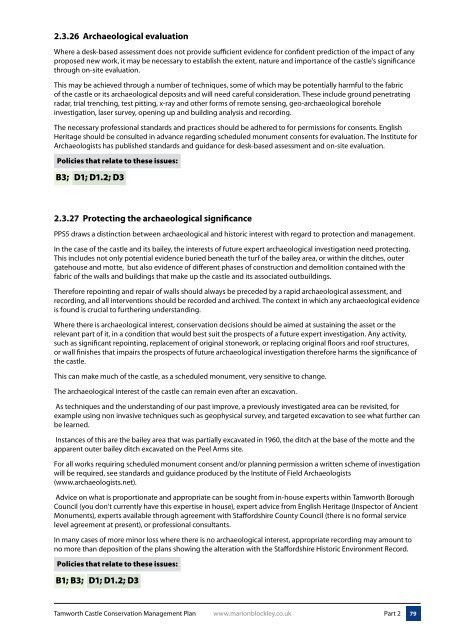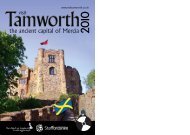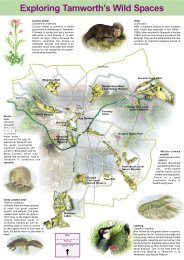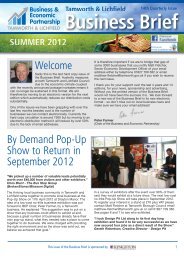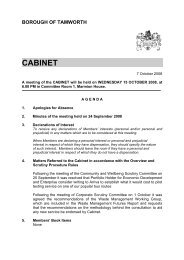Conservation Management Plan - Tamworth Borough Council
Conservation Management Plan - Tamworth Borough Council
Conservation Management Plan - Tamworth Borough Council
You also want an ePaper? Increase the reach of your titles
YUMPU automatically turns print PDFs into web optimized ePapers that Google loves.
2.3.26 Archaeological evaluation<br />
Where a desk-based assessment does not provide sufficient evidence for confident prediction of the impact of any<br />
proposed new work, it may be necessary to establish the extent, nature and importance of the castle’s significance<br />
through on-site evaluation.<br />
This may be achieved through a number of techniques, some of which may be potentially harmful to the fabric<br />
of the castle or its archaeological deposits and will need careful consideration. These include ground penetrating<br />
radar, trial trenching, test pitting, x-ray and other forms of remote sensing, geo-archaeological borehole<br />
investigation, laser survey, opening up and building analysis and recording.<br />
The necessary professional standards and practices should be adhered to for permissions for consents. English<br />
Heritage should be consulted in advance regarding scheduled monument consents for evaluation. The Institute for<br />
Archaeologists has published standards and guidance for desk-based assessment and on-site evaluation.<br />
Policies that relate to these issues:<br />
B3; D1; D1.2; D3<br />
2.3.27 Protecting the archaeological significance<br />
PPS5 draws a distinction between archaeological and historic interest with regard to protection and management.<br />
In the case of the castle and its bailey, the interests of future expert archaeological investigation need protecting.<br />
This includes not only potential evidence buried beneath the turf of the bailey area, or within the ditches, outer<br />
gatehouse and motte, but also evidence of different phases of construction and demolition contained with the<br />
fabric of the walls and buildings that make up the castle and its associated outbuildings.<br />
Therefore repointing and repair of walls should always be preceded by a rapid archaeological assessment, and<br />
recording, and all interventions should be recorded and archived. The context in which any archaeological evidence<br />
is found is crucial to furthering understanding.<br />
Where there is archaeological interest, conservation decisions should be aimed at sustaining the asset or the<br />
relevant part of it, in a condition that would best suit the prospects of a future expert investigation. Any activity,<br />
such as significant repointing, replacement of original stonework, or replacing original floors and roof structures,<br />
or wall finishes that impairs the prospects of future archaeological investigation therefore harms the significance of<br />
the castle.<br />
This can make much of the castle, as a scheduled monument, very sensitive to change.<br />
The archaeological interest of the castle can remain even after an excavation.<br />
As techniques and the understanding of our past improve, a previously investigated area can be revisited, for<br />
example using non invasive techniques such as geophysical survey, and targeted excavation to see what further can<br />
be learned.<br />
Instances of this are the bailey area that was partially excavated in 1960, the ditch at the base of the motte and the<br />
apparent outer bailey ditch excavated on the Peel Arms site.<br />
For all works requiring scheduled monument consent and/or planning permission a written scheme of investigation<br />
will be required, see standards and guidance produced by the Institute of Field Archaeologists<br />
(www.archaeologists.net).<br />
Advice on what is proportionate and appropriate can be sought from in-house experts within <strong>Tamworth</strong> <strong>Borough</strong><br />
<strong>Council</strong> (you don’t currently have this expertise in house), expert advice from English Heritage (Inspector of Ancient<br />
Monuments), experts available through agreement with Staffordshire County <strong>Council</strong> (there is no formal service<br />
level agreement at present), or professional consultants.<br />
In many cases of more minor loss where there is no archaeological interest, appropriate recording may amount to<br />
no more than deposition of the plans showing the alteration with the Staffordshire Historic Environment Record.<br />
Policies that relate to these issues:<br />
B1; B3; D1; D1.2; D3<br />
<strong>Tamworth</strong> Castle <strong>Conservation</strong> <strong>Management</strong> <strong>Plan</strong> www.marionblockley.co.uk<br />
Part 2<br />
79


